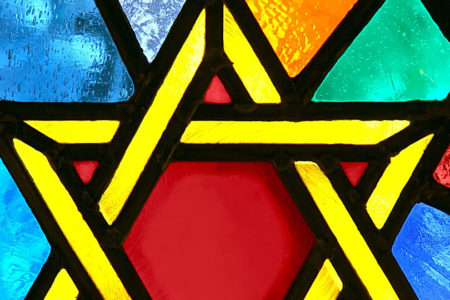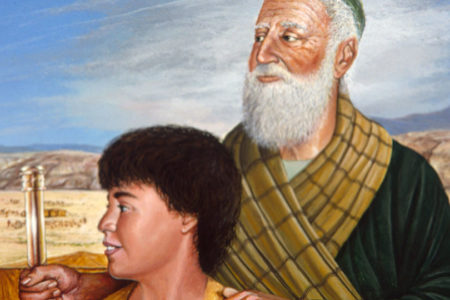The Parting of the Ways
Although it has sometimes been overlooked, a straightforward reading of the Book of Acts reveals that Christianity began as a sect within the Jewish community. Jesus was born of a Jewish mother, was reared in a Jewish home, and grew up in an intensely Jewish culture. All of His disciples were Jewish. During at least the first three decades of its existence, the Church was overwhelmingly Jewish in its membership.
While Paul is often styled the “Apostle to the Gentiles,” it should not be overlooked that, wherever he traveled, he always ministered first to his “brethren according to the flesh” (see Acts 13:5, 14; 14:1; 16:13; 17:1–2; 18:4, 19). Often he ministered in synagogues. The early Jewish believers initially continued to attend synagogue after they had received Jesus as their Messiah. In his letter to Jewish believers in the dispersion, James actually referred to their assembly place as a “synagogue” (Jas. 2:2, literal translation from the original Greek).
It was only natural for these Hebrew Christians to continue to do this, since they considered their Messiah to be the fulfillment of the same Scriptures that were read each Sabbath in the synagogue. Almost without exception, however, their presence and faith initiated hostility among the other members of the synagogue who disagreed with them (e.g., see Acts 17:49). It is interesting to note that the believers did not initiate the hostility, but conflict seemed inevitably to erupt in the synagogue if some members accepted Jesus as their Messiah.
As was mentioned previously, during the early decades of her existence, the Church was composed predominantly of Jewish people. As a matter of fact, the term Christian was not widely used during this early period of Church history. The word is found only twice in the book of Acts (11:26; 26:28). The terms applied to them were usually believers (Acts 2:44; 4:32; 19:18; 21:20, 25) or those of the way (Acts 9:2; 19:9, 23; 22:4). Another term for them, probably applied by opponents, was Nazarenes (Acts 24:5). This last term identified them as followers of the Nazarene (i.e., the one from Nazareth, cp. Mt. 2:23; Mk. 14:67; 16:6).
Eusebius, a fourth-century historian, wrote that the Jewish believers in Jerusalem left that city before the Romans besieged and destroyed it in 70 A.D. They went to a little town called Pella on the eastern side of the Jordan River. After the war they returned to Jerusalem. Eusebius also tells us that the pastoral leadership of these Jerusalem believers, so ably handled earlier by James, continued to be held by a Jewish believer until at least 135 A.D.1
A serious problem arose during the period following 70 A.D. Some Jewish believers during this transition period continued to regularly attend their synagogues. The legal status of these Hebrew Christians in the synagogue continued to confront the rabbis. How the Jewish leadership eventually dealt with this problem of the Nazarenes’ presence is vital to our understanding of what took place in the eventual parting of the ways between the Jews who followed Jesus and those who followed the Pharisees’ rejection of Him.
The Sanhedrin had been recognized as the official legislative court of appeal for the Jewish people since the days of Ezra. It consisted of 70 members, and its head was usually the high priest (Mt. 26:57–59). After the destruction of Jerusalem, they reorganized themselves under the leadership of the Pharisee Yohanan ben Zakkai in the coastal town of Yavneh near present-day Tel Aviv. There, during the following years, the rabbis attempted to rebuild the structure of Jewish practice and worship. They decided many issues, including affirming the list of books that already had been recognized as the canon of the Hebrew Scriptures. One of the problems these rabbis discussed was what to do about Jews who believed in Jesus and still attended the synagogue. Around 90 A.D. the famous prayer called the Shemoneh Esrah was formulated in its Palestinian version. In a slightly different version, it is still prayed three times a day by orthodox Jews and always in the synagogue service on Shabbat. Petition twelve of the prayer reads as follows in the oldest version:
And for apostates let there be no hope; and may the insolent kingdom be quickly uprooted, in our days. And may the Nazarenes and the heretics perish quickly; and may they be erased from the Book of Life; and may they not be inscribed with the righteous. Blessed art thou, Lord, who humbles the insolent.2
Obviously, a Nazarene could not publicly pray this curse on himself. Therefore, it became impossible for any of them to remain in the synagogue life and worship. The inevitable parting of the ways had taken place. From 90 A.D. until today, therefore, the official attitude of Judaism, as defined by its own leadership, is that Jewish believers are not welcome as synagogue participants. Although they were always considered to be Jewish—a fact that is clear in Jewish religious law—they were to be viewed as “heretics.”
Some modern Jewish believers, who often call themselves “Messianic Jews” and who sometimes seek to proclaim themselves as the “fourth branch of Judaism,” must recognize this historical reality. While it is true that faith in Jesus is consistent with the teaching of the Hebrew Scriptures, Judaism has defined itself in a way that simply excludes Jewish believers in Jesus. There are irreconcilable differences between the doctrinal beliefs of the two faiths in regard to the Messiah, the nature of God, and the meaning of redemption. To think that Judaism will include the followers of Jesus in its family is to ignore the facts of history. To seek to be accepted by them is an exercise in futility.
The final stage in the parting of the ways took place in the generation following that of the rabbis of Yavneh. Jews and Nazarenes did not worship together during that time, but Nazarenes were still considered to be part of the wider Jewish community. Even that accommodation was soon altered. From 132 to 135 A.D., the Jewish people in the land of Israel again revolted against their Roman overlords. They were led by a military commander named Ben Koseba. The great rabbi Akiba actually proclaimed him to be the long-awaited Messiah and called him “Bar Cochba” (lit., son of the star), a reference to Balaam’s prophecy in Numbers 24:17. The Nazarenes living in Israel obviously were confronted with a major dilemma. While they may have sympathized with their Jewish brethren against the Romans, could they take up arms, particularly under the banner of a leader whom they regarded as a false messiah? Since they believed that the true Messiah had already come, they refused to participate in the rebellion. For this refusal, they were persecuted by Bar Cochba and castigated by their Jewish neighbors. They had been expelled from the Jewish synagogues only a few decades before, and now they were actually expelled from the Jewish communities. Some of them paid a heavy price for remaining loyal to their Messiah. It was during these troubled days that the term meshumad (lit., destroyer) was applied to them in the sense of being traitors. Unfortunately, the use of that term still continues today in reference to Jewish believers by families and friends who cannot comprehend their messianic faith in Jesus.
The Nazarenes continued to exist as an identifiable group into the third century. Another term used for them in rabbinic literature is the Hebrew word minim. The meaning of this term is kinds, and it is used in Genesis 1:11, 12, 21, 24, 25 for the kinds of plants and animals and the ways in which they reproduced. When the rabbis used this term for a Nazarene, the intended reference was to a Jew of a different kind—still a Jew, but a different kind of Jew.
Unfortunately, among the Nazarenes there developed a heretical sect called the Ebionites who denied the deity of Jesus and viewed Paul in a negative way. The Ebionites’ beliefs were probably the inevitable result of too strong an identification with rabbinic culture on the part of some Nazarenes. Opposed strongly by the Church fathers, this unorthodox group eventually disappeared.
There are some lessons to be learned from this brief survey of the history of Jewish believers in the early Church.
- Jewish believers today are consistent with their ancient forebears in seeing their faith as the correct fulfillment of the Hebrew Scriptures’ messianic hope.
- Some Jewish believers today are naive in thinking that the modern synagogue, controlled by rabbinic theology, will ever accept them as a viable part of the Jewish community. Whether they like it or not, the parting of the ways is an historical reality that cannot be ignored.
- It is legitimate for Jewish believers today to appreciate their cultural heritage but not to place a strong emphasis on rabbinic customs rather than biblical standards.
- There is an ever-present danger that a close identification with rabbinic ideas will degenerate into doctrinal heresy, as was the case with the Ebionites. Faithfulness to biblical teaching about the person of Christ and the exclusive character of salvation as solely through Him are simply nonnegotiable items.
May the Lord spare the present, mighty work of salvation that is taking place among the Jewish people from such excesses and errors that would mar its vital witness and endanger its faithfulness to the Lord, whom it professes to follow.
ENDNOTE
- Eusebius Pamphylius, The History of the Church, Book 2, 5 and Book 4, 5.
- Emil Schurer, T. and T. Clark, History of the Jewish People in the Age of Jesus Christ, vol. II (Edinburgh: 1979), 461.









It’s tragic today that when a Jew accepts Jesus or “that Man” as Messiah they are ostracized. I recently had an orthodox Jew tell me Messianic Jews are no longer considered Jews. Yet they are in the eyes of the One who matters. When Jews need all the allies they can get it’s so tragic that they would castigate their own people. It’s especially tragic when in their stubborness to continue to reject the Messiah they themselves will be castigated from God eternally. Thanks to the author for this article.